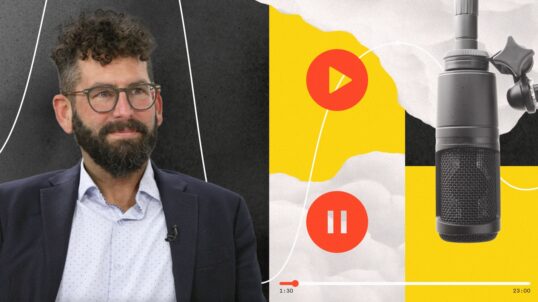Editor’s Note: This blog post is the second in a series resulting from a conversation between eCity Interactive and Chris Barrows of NYU and Joel Renner of George Washington University. Check back in the coming weeks for future articles about social media and higher education.
There’s no denying the explosion of social media usage within the past decade. So widespread is its popularity, even the most notoriously slow-moving industries (ahem, higher ed) have begun to embrace the benefits of meeting their audience where they already are. And an abundance of data shows that for colleges and universities, the audience is on social.
We recently chatted with two higher ed pros about the impact of social media on higher ed institutions: Chris Barrows, host of the “Why I Social” podcast and Digital Marketing Professional at NYU, and Joel Renner, founder of @socialroadtrip and Manager of Digital Strategy at George Washington University’s School of Business. In general, both Barrows and Renner agreed that schools are headed in the right direction when it comes to social media. “I think we’re starting to get towards the path where schools are getting it. They are realizing that this is important,” says Barrows.
Although most schools understand the importance of having a social presence, it’s still up for discussion about how to best manage that presence. Throughout our conversation with Barrows and Renner, the duo offered up numerous examples of schools getting it right with social, as well as a few cautionary tales. From these examples, we’ve identified four do’s and don’ts to keep in mind as you navigate the exciting (and sometimes bureaucratic) landscape of social media in higher education.
Do: Go where your audience is
One of the main reasons social media has gained credibility in the higher ed space is because of its undeniable popularity among teenagers and young adults. “Every single person we deal with is on it [social media],” says Renner. “That’s pretty much early admission through all the students, through grad students, through alums. Every single person that we touch is there, so if there’s any industry that understands the Snapchat generation, it’s higher ed folks,” says Renner.
It’s no longer just the marketing teams within colleges and universities who are on board with social media for higher ed. According to Renner, leadership teams are starting to see the value of participating on these platforms as well. “If we’re not there, we’re missing our audience and they see it,” says Renner. The data is there to back him up: 90% of young adults (ages 18-29) use social media, according to a 2015 Pew Research Center study. If you want to reach your audience – whether it’s prospective students, current students, or alumni – embracing social media is the first step in the process.
Don’t: Haphazardly join every network
As social media platforms continue to add competitor features, it can be tempting to blanket each social network with the same piece of content. Part of this is because it’s now easier than ever to take a Snapchat story and repurpose that content into a story for Instagram. “You can bring over a campaign and modify a campaign that has live video, that has all the various pieces that a lot of the other networks would have,” says Renner. But don’t forget that each platform has its own audience. Consider who that audience is and “edit what you’re looking at from a campaign perspective based on the social network that you’re using,” says Renner.
“I do think there are some people who try to do it everywhere, but I think there’s a better understanding now that you don’t need to be everywhere. You need to be in the right places,” says Barrows. “You do have to do the leg work and discover where do we need to be.”
What places offer the most value for higher ed? “There’s still tremendous value in Facebook, and there’s Instagram, and Snapchat honestly could be the main hub of your content and you would see results on an enormous level,” says Barrows. The main takeaway? Know your audience and cultivate a strong presence on the networks that matter most to them.
Do: Build a community on social media
In the first blog post based on our conversation with Barrows and Renner, we talked about the importance of engaging young alumni in ways that don’t involve asking for money. We noted the importance of building relationships with alumni before they graduate, instead of reaching out only when it’s time to generate donations. Social media is designed for exactly this type of relationship building.
Many schools are already using social media as a way to provide value and build trust with students. “I like that we’re thinking not as much as marketing, but actually serving a community,” says Renner of higher ed’s use of social media. He advises schools to use social media mainly as a way to build a community of engaged prospective students, current students, and alumni. By focusing on the community aspect of social media, schools will put themselves in a much better position down the road when it’s time to reach out to alumni for help.
Don’t: Use social media as a marketing megaphone
The way higher ed institutions use social media tends to vary greatly from the way businesses use these platforms. According to Renner, this is a good thing. “We’ve got so many people trying to market, market, market on Snapchat,” says Renner. “You’ve got these people who aren’t in higher ed unfortunately trying to tell you how to market on Snapchat, and that’s not how it works in higher ed,” notes Renner. The consensus? Higher ed pros know what works for students and how students are using social media, and should stick to serving their needs rather than blasting out marketing messages.
Do: Take a strategic approach to social media
As an increasing number of schools use Snapchat to reach their target demographic, both Barrows and Renner have noticed a shift in the thinking surrounding social media and higher ed. More so than on other social networking platforms, higher ed professionals are taking a more strategic approach to Snapchat in particular. This trend is exactly what led Barrows and Renner to co-found Snapchat.Education, a community of contributors aimed at helping schools use Snapchat strategically. “They are handing off control to students on Snapchat. They aren’t doing that on other social networks,” says Barrows.
Related: See how these six schools are killing it on the Snapchat scene.
Renner made reference to two schools in particular who have taken a more strategic approach to Snapchat. Beloit College, a private school in Beloit, Wisconsin, has started using Snapalytics to track Snapchat metrics. “My alma mater, UW Green Bay, University of Wisconsin Green Bay, gave out their acceptance notifications [on Snapchat],” says Renner. These are huge steps in the right direction, and a trend that’s likely to continue and expand to other platforms as well.
As schools begin feeling more comfortable experimenting with student-generated content and live video content across different social media platforms, Renner and Barrows predict that A/B testing will play an increasing role in higher ed social media strategy. Both noted that they’ve already seen a shift in the way higher ed social media teams approach these different platforms. Rather than sticking to what’s expected on each social network, schools are A/B testing different approaches and seeing what works best for each particular audience.
Don’t: Let misconceptions about social media in Higher Ed hinder you
Although social media and higher ed have come a long way in the last few years, there’s unfortunately still misconceptions about the work social media practitioners do. “People know we have to do it, but people still don’t look at it as professional,” says Barrows. It’s important to communicate to leadership the importance of having a set strategy in place when it comes to social media.
“I think the misconception is that we have to be on social, but it is not about strategy,” says Renner. All too often, leadership in higher ed makes hasty requests without considering the strategy necessary to reach those goals. It’s almost become common practice to contact the marketing department as a last ditch effort to boost attendance for an event. Instead, Renners advocates for a more strategic and collaborative approach to social media marketing efforts. That way, there’s been some pre-work done, and the campaign can be more successful upon launch. Sadly, this type of planning doesn’t always happen in higher ed, and that hinders social media teams as a result. To avoid this fate and ensure you’re in a position to provide maximum value as a practitioner of social media, make sure strategy is part of the conversation from the get-go.
Do: Adapt a well-rounded understanding of digital marketing
“It’s not good enough as a professional to just be a social media person. You need a digital understanding,” says Barrows. In order to to remain relevant in the world of higher education marketing, it’s important to diversify your experience. “[Social media] is mixed in as part of a job, and if we’re not truly digital marketers with a greater understanding of advertising, email marketing, et cetera, we’re going to be in trouble as professionals,” says Barrows. By taking a more well-rounded approach to digital marketing, you’ll be able to see the bigger picture and ensure alignment across all marketing efforts.
Don’t: Blindly follow social media marketing trends
According to Barrows, higher ed institutions don’t just need a person who understands social media, but a person who understands that it’s about more than just looking at a trend. For example, Barrows references a recent myth-busting article that downplayed the importance of mobile apps on campus. “The bottom line is at NYU, our mobile app is still extremely beneficial and it works,” says Barrows. Always consider your individual audience and what works best for them. “You can’t just look at a trend and say ‘We need to do this because there’s a trend that says we have to do it’,” says Barrows.
As higher ed social media veterans, both Barrows and Renner are uniquely qualified to offer insight into what’s working for schools on social media and what to avoid. It’s clear from their experience and observations that the key to getting social media in higher ed right is to know your audience. Know where they are, what they’re interested in, and what valuable information you can provide them.
Higher education institutions have a different purpose than businesses, and should stay true to that purpose when using social media as a means of connecting with their community. By adopting a more well-rounded view of digital marketing as a whole, and using this knowledge to take a more strategic approach to social media in particular, colleges and universities can set themselves apart in the eyes of high school seniors, current students, and proud alumni.




